13.2: Wave Behavior and Bonding in the Hydrogren Molecule
- Page ID
- 192602
\( \newcommand{\vecs}[1]{\overset { \scriptstyle \rightharpoonup} {\mathbf{#1}} } \)
\( \newcommand{\vecd}[1]{\overset{-\!-\!\rightharpoonup}{\vphantom{a}\smash {#1}}} \)
\( \newcommand{\id}{\mathrm{id}}\) \( \newcommand{\Span}{\mathrm{span}}\)
( \newcommand{\kernel}{\mathrm{null}\,}\) \( \newcommand{\range}{\mathrm{range}\,}\)
\( \newcommand{\RealPart}{\mathrm{Re}}\) \( \newcommand{\ImaginaryPart}{\mathrm{Im}}\)
\( \newcommand{\Argument}{\mathrm{Arg}}\) \( \newcommand{\norm}[1]{\| #1 \|}\)
\( \newcommand{\inner}[2]{\langle #1, #2 \rangle}\)
\( \newcommand{\Span}{\mathrm{span}}\)
\( \newcommand{\id}{\mathrm{id}}\)
\( \newcommand{\Span}{\mathrm{span}}\)
\( \newcommand{\kernel}{\mathrm{null}\,}\)
\( \newcommand{\range}{\mathrm{range}\,}\)
\( \newcommand{\RealPart}{\mathrm{Re}}\)
\( \newcommand{\ImaginaryPart}{\mathrm{Im}}\)
\( \newcommand{\Argument}{\mathrm{Arg}}\)
\( \newcommand{\norm}[1]{\| #1 \|}\)
\( \newcommand{\inner}[2]{\langle #1, #2 \rangle}\)
\( \newcommand{\Span}{\mathrm{span}}\) \( \newcommand{\AA}{\unicode[.8,0]{x212B}}\)
\( \newcommand{\vectorA}[1]{\vec{#1}} % arrow\)
\( \newcommand{\vectorAt}[1]{\vec{\text{#1}}} % arrow\)
\( \newcommand{\vectorB}[1]{\overset { \scriptstyle \rightharpoonup} {\mathbf{#1}} } \)
\( \newcommand{\vectorC}[1]{\textbf{#1}} \)
\( \newcommand{\vectorD}[1]{\overrightarrow{#1}} \)
\( \newcommand{\vectorDt}[1]{\overrightarrow{\text{#1}}} \)
\( \newcommand{\vectE}[1]{\overset{-\!-\!\rightharpoonup}{\vphantom{a}\smash{\mathbf {#1}}}} \)
\( \newcommand{\vecs}[1]{\overset { \scriptstyle \rightharpoonup} {\mathbf{#1}} } \)
\( \newcommand{\vecd}[1]{\overset{-\!-\!\rightharpoonup}{\vphantom{a}\smash {#1}}} \)
\(\newcommand{\avec}{\mathbf a}\) \(\newcommand{\bvec}{\mathbf b}\) \(\newcommand{\cvec}{\mathbf c}\) \(\newcommand{\dvec}{\mathbf d}\) \(\newcommand{\dtil}{\widetilde{\mathbf d}}\) \(\newcommand{\evec}{\mathbf e}\) \(\newcommand{\fvec}{\mathbf f}\) \(\newcommand{\nvec}{\mathbf n}\) \(\newcommand{\pvec}{\mathbf p}\) \(\newcommand{\qvec}{\mathbf q}\) \(\newcommand{\svec}{\mathbf s}\) \(\newcommand{\tvec}{\mathbf t}\) \(\newcommand{\uvec}{\mathbf u}\) \(\newcommand{\vvec}{\mathbf v}\) \(\newcommand{\wvec}{\mathbf w}\) \(\newcommand{\xvec}{\mathbf x}\) \(\newcommand{\yvec}{\mathbf y}\) \(\newcommand{\zvec}{\mathbf z}\) \(\newcommand{\rvec}{\mathbf r}\) \(\newcommand{\mvec}{\mathbf m}\) \(\newcommand{\zerovec}{\mathbf 0}\) \(\newcommand{\onevec}{\mathbf 1}\) \(\newcommand{\real}{\mathbb R}\) \(\newcommand{\twovec}[2]{\left[\begin{array}{r}#1 \\ #2 \end{array}\right]}\) \(\newcommand{\ctwovec}[2]{\left[\begin{array}{c}#1 \\ #2 \end{array}\right]}\) \(\newcommand{\threevec}[3]{\left[\begin{array}{r}#1 \\ #2 \\ #3 \end{array}\right]}\) \(\newcommand{\cthreevec}[3]{\left[\begin{array}{c}#1 \\ #2 \\ #3 \end{array}\right]}\) \(\newcommand{\fourvec}[4]{\left[\begin{array}{r}#1 \\ #2 \\ #3 \\ #4 \end{array}\right]}\) \(\newcommand{\cfourvec}[4]{\left[\begin{array}{c}#1 \\ #2 \\ #3 \\ #4 \end{array}\right]}\) \(\newcommand{\fivevec}[5]{\left[\begin{array}{r}#1 \\ #2 \\ #3 \\ #4 \\ #5 \\ \end{array}\right]}\) \(\newcommand{\cfivevec}[5]{\left[\begin{array}{c}#1 \\ #2 \\ #3 \\ #4 \\ #5 \\ \end{array}\right]}\) \(\newcommand{\mattwo}[4]{\left[\begin{array}{rr}#1 \amp #2 \\ #3 \amp #4 \\ \end{array}\right]}\) \(\newcommand{\laspan}[1]{\text{Span}\{#1\}}\) \(\newcommand{\bcal}{\cal B}\) \(\newcommand{\ccal}{\cal C}\) \(\newcommand{\scal}{\cal S}\) \(\newcommand{\wcal}{\cal W}\) \(\newcommand{\ecal}{\cal E}\) \(\newcommand{\coords}[2]{\left\{#1\right\}_{#2}}\) \(\newcommand{\gray}[1]{\color{gray}{#1}}\) \(\newcommand{\lgray}[1]{\color{lightgray}{#1}}\) \(\newcommand{\rank}{\operatorname{rank}}\) \(\newcommand{\row}{\text{Row}}\) \(\newcommand{\col}{\text{Col}}\) \(\renewcommand{\row}{\text{Row}}\) \(\newcommand{\nul}{\text{Nul}}\) \(\newcommand{\var}{\text{Var}}\) \(\newcommand{\corr}{\text{corr}}\) \(\newcommand{\len}[1]{\left|#1\right|}\) \(\newcommand{\bbar}{\overline{\bvec}}\) \(\newcommand{\bhat}{\widehat{\bvec}}\) \(\newcommand{\bperp}{\bvec^\perp}\) \(\newcommand{\xhat}{\widehat{\xvec}}\) \(\newcommand{\vhat}{\widehat{\vvec}}\) \(\newcommand{\uhat}{\widehat{\uvec}}\) \(\newcommand{\what}{\widehat{\wvec}}\) \(\newcommand{\Sighat}{\widehat{\Sigma}}\) \(\newcommand{\lt}{<}\) \(\newcommand{\gt}{>}\) \(\newcommand{\amp}{&}\) \(\definecolor{fillinmathshade}{gray}{0.9}\)In the early 20th Century, our understanding of light and matter was progressing very quickly, but some things still didn't make sense to people. Things really started to click when a number of physicists started thinking about things in a different way. One of the revolutionary things they did was to treat seriously, with mathematical equations, the wave nature of light and matter.
In the case of light, the idea actually dates back to the mid-17th Century. Christiaan Huygens, a Dutch clockmaker and astronomer, believed that light traveled in waves because he could see evidence of interference patterns in light, much like the way ripples on a pond can interfere with each other to produce new patterns. Other scientists, such as Newton, really thought light was made of small particles. In a sense, both were right, and we now think of particles of light, or photons, as having some of the properties of waves.
What do we know about waves? Waves on the surface of a lake or an ocean are good examples. You probably took a detailed look at them around 6th grade, although you may have forgotten some of the details. So, let's take another look.
Maybe you have stood beside a wave tank at a science museum and seen something that looks like this. The surface of the water undulates up and down. There are crests where the water mounds up in hills and troughs where the water slips away into valleys. Somewhere in between, there is an average water level, where the surface would settle if things were calm and there were no waves at all.

We can also think of waves as having null points or nodes; those are the positions halfway in between the crest and the trough.

Max Planck and Albert Einstein each took a closer look at that idea in the early 1900's when they were trying to determine the relationships between electrons in materials and their interaction with electromagnetic radiation. Electromagnetic radiation includes things like ultraviolet and visible light.
If we are standing at the seaside, one of the first things we notice about the waves is how tall they are. Maybe it's a really calm day and the waves are almost flat. Maybe it's a really rough day and the waves are really tall. The feature of waves that you are noticing is called the amplitude. That's the height of the wave from the average water level to the crest, or, conversely, the depth down to the trough. In the macroscopic world, the amplitude of the waves is really important. You need to know whether it's OK to stand and watch the waves, or whether it's getting too rough and you should seek higher ground. If you aren't careful, a really high amplitude wave could come crashing down on you.
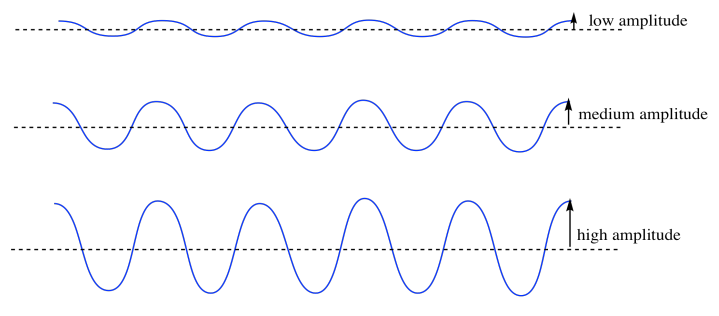
Waves on the ocean can have high amplitude or low amplitude, and there is a physical consequence. Sound waves can also have high amplitude (those are the loud ones) or low amplitude (those are the quiet ones). Of course, if the amplitude were really, really low, we would almost have no wave at all (when that person is whispering a secret but you can't even hear them).
In the nanoscale world, the world of photons and electrons, the amplitude of a wave is a much more subtle thing. It isn't our first consideration. What's much more important is the wavelength. The wavelength is just the distance from one crest to the next, or from one trough to the next.

The wavelength is really important because, according to Planck and Einstein's analysis of experimental data, it's what determines the energy of an individual photon, or the energy of an individual electron. The shorter the wavelength of a photon or electron, the higher its energy. The longer the wavelength of a photon or electron, the lower its energy. This relationship is an example of inverse proportionality: when one gets bigger, the other gets smaller.

There is a complementary attribute of waves, and that is frequency. We can think of frequency as how often a wave crests. Alternatively, if we picture an electromagnetic wave passing a stationary object, the frequency would describe how often a crest passes the object. (All light travels at the same speed, about 3 x 108 m s-1, so we don't have to worry about that being a factor.)

Frequency is inversely proportional to wavelength: the longer the wavelength, the lower the frequency. Consequently, frequency is directly proportional to the energy of the photon or electron. The higher the frequency, the higher the energy.
Exercise \(\PageIndex{1}\)
Between each pair, which wave has greater energy?
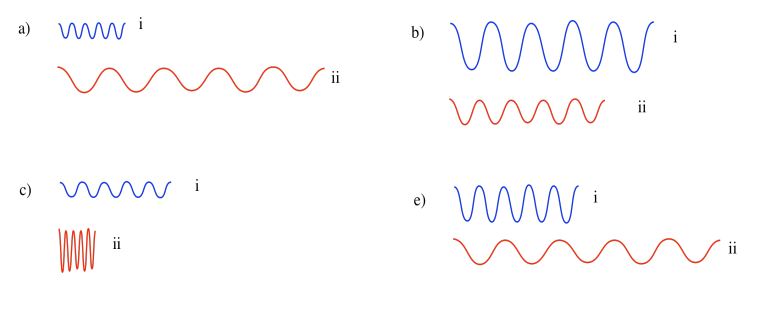
- Answer
-
In each case, the wave with the higher frequency and shorter wavelength would have the higher energy. a) i; b) ii; c, ii; e) i.
Let's return to Christiaan Huygens' original observation of interference patterns in light. What does that mean?
Suppose two waves come together. We'll think about two different cases. In the first case, the two waves are in-phase with each other. That means that they both crest at the same time and their troughs are always aligned, too. What happens then? You can imagine the crests will just build on each other, getting taller, and the troughs will fall into each other, getting deeper. The amplitude of the waves, together, increases. This is constructive interference.

Now suppose that the two waves are out-of-phase. When one crests, the other bottoms out. In that case, the crest of one wave falls into the trough of the other. Everything levels out. This is destructive interference.
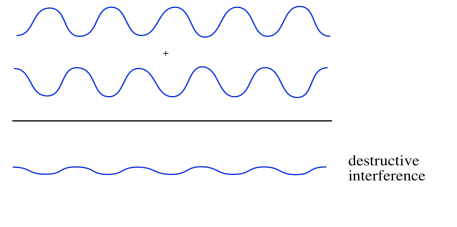
Constructive interference and destructive interference also occurs with waves on the water. That leads to lots of ripple patterns if you toss two stones into a still pond. Photons can also produce those kinds of patterns, and so can electrons.
Lewis suggests that two atoms with unpaired electrons may share their electrons to form a bond. In a Lewis structure, we can draw those two electrons between the symbols for the two atoms to show that a bond has formed. Quantum mechanics offers a quantitative mathematical view of molecules, and is considered to give an accurate picture of the behavior of atoms and molecules. Now, instead of putting two atoms beside each other and letting two dots get together to form a bond, like in a Lewis structure, we'll think about bonding in quantum mechanical terms.
- Two hydrogen atoms are placed next to each other.
- The two atoms are surrounded by the waves formed by their electrons.
- If the two atoms are close together, these two waves overlap in between the two atoms.
What happens when waves overlap? Interference patterns develop. Think of a flat, calm pond, into which you and a friend throw two small stones, a few feet apart. The resulting ripples move out in circles from the two points where the stones fell in, and when the two sets of waves meet each other, new patterns result. The circular sets of waves combine to form new waves with new shapes.
When waves meet, there are two basic combinations that result. These combinations depend on whether the two waves are in-phase or out-of-phase with each other.
- If the waves are in-phase, so that the peak of one wave lands on top of the peak of another, and the trough of one wave coincides with the trough on the other, constructive interference occurs. The waves add up, and get bigger where they overlap.
- If the waves are exactly out-of-phase, the peak of one falls into the trough of another, and where they overlap the two waves are canceled out. This is destructive interference.
We can apply these ideas to the electrons in atoms that come together to make a bond. In Lewis structures, individual electrons on two different atoms are paired up in a bond between the two atoms. The electrons have to be combined to make a bond. If electrons have wave properties, then there will be interference patterns that result when these atoms come together.
Before we start, note that the waves that we will be dealing with look a little different from the standing waves we looked at before. These waves will be three-dimensional and will occupy different regions of space. Instead of drawing phase information as peaks and troughs, we are going to use a common convention of shading to signify whether we are looking at the positive part (in terms of phase) or the negative part of a wave. For example, we might show the crests in blue and the troughs in red, or we might show one in black and the other in white. In a standing wave, the phases would look like this:

In a hydrogen atom, the electron is found in a spherical area around the nucleus. We won't be able to see two distinct phases - a crest and a trough - in this wave at one time. However, we could look at two different hydrogen atoms and illustrate whether their electrons are in-phase or out-of-phase with each other.

When those two electrons come together and they are in-phase with each other, constructive interference occurs. They won't overlap completely; these are atoms and they take up space. However, they will be able to sit pretty close to each other, sort of smushing their electrons together. That constructive interference will happen in the middles, between the atoms.

When the two electrons come together and they are out-of-phase, destructive interference occurs. Again, that will happen in the middle, between the atoms.
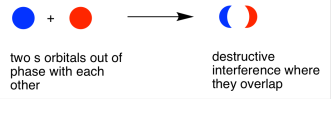
So, in the pair of hydrogen atoms, two waves can combine to produce two possible outcomes.
- In one, the height of the combined wave is highest between the two atoms, where they are overlapping and in-phase. The amplitude of the wave is greater here.
- In the other case, the combined wave is composed of two halves that are out-of-phase, and there is no wave at all between the two atoms, where they have canceled out; the amplitude of this wave is zero between the two nuclei.
Those two possible combinations produce two different results. We keep track of these outcomes using a molecular orbital interaction diagram. The diagram says that the two orbitals can combine in two different ways: in-phase or out-of-phase. The diagram also tells us that the in-phase combination results in a decrease in energy when the two atoms come together. The out-of-phase combination results in an increase in energy when the atoms come together.

Figure \(\PageIndex{1}\): A molecular orbital interaction diagram for H2. A hydrogen atom 1s orbital is shown on the left with its accompanying energy level. The same is shown on the right. In the middle of the diagram, the two hydrogen 1s orbitals can combine in two ways: in-phase and out-of-phase. These combinations produce two new orbitals (or electron waveforms) with two new energy levels.
Why does the in-phase combination go down in energy, whereas the out-of-phase combination goes up?
Consider the idea that these waves each have a wavelength, and that this wavelength is related to kinetic energy. For the 1s electron on a hydrogen atom, we can really only visualize half the wave; this half-wave is basically the size of a hydrogen atom, so the total wavelength would be two hydrogen atoms long (for lack of a better yardstick).
For the out-of-phase combination, we can visualize the entire wave, both its "peak" on one side and the "trough" on the other. The two hydrogen atoms are not merely sitting beside each other, they are actually overlapping, so that the distance from one end of the wave to the next is actually somewhat less than two hydrogen atoms. Let's say it's one and a half hydrogen atoms long. This wave has a shorter wavelength than the waves on either individual hydrogen atom, and so it is at higher energy.
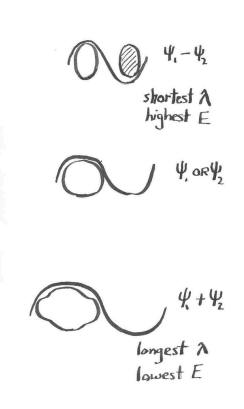
Figure \(\PageIndex{2}\): A comparison of wavelengths as seen along the bond axis in dihydrogen.
For the in-phase case, again, the two hydrogen atoms are overlapping. But this time we can only visualize half the wave; so the total wavelength would be longer than two hydrogen atoms. Maybe it's three hydrogen atoms long. This wave has a longer wavelength than the electron in an individual hydrogen atom, so it is at lower energy.
- The combination of atomic orbitals results in new, molecular orbitals.
- The number of atomic orbitals combined = the number of molecular orbitals produced.
- In-phase (low energy) and out-of-phase (high energy) combinations are possible.
And now for the weird part:
- According to quantum mechanics, the in-phase and out-of-phase combinations occur simultaneously.
Where would the two electrons actually go? The aufbau process used for atomic electron configurations holds true here. Two electrons can be found in the same space provided they are spin-paired; one would have spin "up" and the other one spin "down". Both electrons could be found in the lower energy orbital. That means both hydrogen electrons go down in energy when H2 forms; the formation of a hydrogen molecule from two hydrogen atoms is thus exothermic.
- The occupied orbital is called a bonding orbital; it is responsible for the bond energy in H2.
- Bond energy refers to the amount of energy given off when a bond forms.
What would happen if each hydrogen atom brought two electrons with it? Would two hydride ions form a bond?
- There would be four electrons in an H22- molecule.
- The first two electrons would occupy the lower, bonding orbital.
- The next two electrons would occupy the upper orbital
- Overall, there would be no net loss of energy, so a bond would not form.
- The out-of-phase combination is called an antibonding orbital, because its increase in energy offsets the decrease in energy that occurs when electrons go into a bonding orbital.
- Placing electrons in an antibonding orbital weakens or breaks a bond.
What does quantum mechanics tell us about bonding that we can't learn from Lewis structures? We learn that electrons can sometimes lower their kinetic energy by forming bonds. If that is the case, the bond will form. On the other hand, if kinetic energy cannot be lowered, the bond won't form at all.
- Covalent bonds form because electrons can adopt longer wavelengths.
- Electrons with longer wavelengths have lower kinetic energy.
Exercise \(\PageIndex{2}\)
Add a few words to explain the ideas conveyed in these drawings.
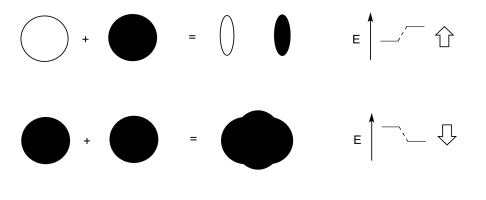
- Answer
-
When two s orbitals combine out-of-phase, destructive interference occurs.
There is a node between the atoms.
The energy of the electrons increases.
When two s orbitals combine in-phase, constructive interference occurs.
There is no node between the atoms; the electrons are found between the atoms.
The energy of the electrons decreases.


